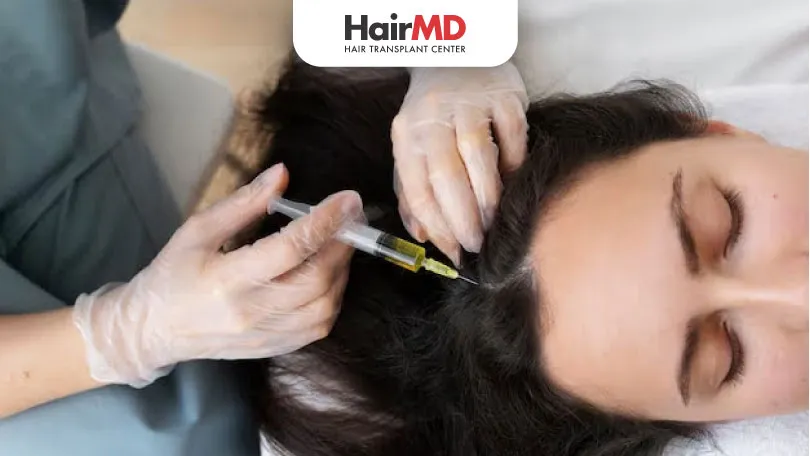28th Nov, 2023

What’s covered in the article?
- What is Female Pattern Hair Loss?
- The Science Behind PRP Therapy
- Why Choose PRP Therapy for Female Pattern Hair Loss?
- The Benefits of PRP Therapy
- Personalized Treatment Plans
- Get your Confidence Back!
- Conclusion
What is Female Pattern Hair Loss?
Female Pattern Hair Loss, medically known as Female Androgenetic Alopecia, is a common form of hair thinning that predominantly affects women. It manifests as a reduction in hair density on the scalp, often exacerbated by hormonal changes and genetic factors.
Let’s break down the key aspects:
- Genetics: Often, FPHL runs in families, indicating a strong genetic predisposition to this type of hair loss.
- Hormonal Changes: Life stages such as pregnancy or hormonal imbalances as seen with PCOS or menopause can trigger or worsen FPHL.
- Aging: As women age, the likelihood and severity of FPHL can increase.
This type of hair loss generally presents a distinct pattern, primarily affecting the top and front of the scalp, and although it is more common as women age, it can start as early as the late teens.
The Science Behind PRP Therapy
Platelet-Rich Plasma (PRP) Therapy is a state-of-the-art treatment that uses your own blood to help stimulate hair growth. This treatment is especially effective for those experiencing hair thinning.
Here’s a detailed look at how it is done:
- Extraction and Preparation: Initially, a healthcare professional draws a small amount of your blood. This sample is then placed in a centrifuge. The centrifuge spins at a high speed, which separates the blood into layers. The platelets and plasma, which are crucial for the treatment, are isolated from the other blood components.
- Activation and Application: Next, the collected platelets are activated to release growth factors that are essential for healing and hair growth. These activated platelets are then carefully injected into specific areas of your scalp where hair is thinning. This process targets the very spots that need growth stimulation, making it highly effective.
The growth factors released by the platelets perform critical functions. They regenerate hair follicles, increase blood flow, and enhance the thickness of the hair shaft. This leads to new hair growth and thickens existing hair. PRP is a non-surgical approach and relies entirely on natural healing elements within your body, significantly reducing the risk of side effects.
This procedure promotes natural hair growth and improves scalp health dramatically. It’s a safe, reliable, and preferred method for treating hair thinning without resorting to drastic surgical measures. This non-surgical procedure is celebrated for its natural approach and minimal risk of side effects.
Why Choose PRP Therapy for Female Pattern Hair Loss?
PRP (Platelet-Rich Plasma) therapy is highly recommended for treating Female Pattern Hair Loss (FPHL) for several effective reasons. It stands out as a significant treatment option due to its direct approach in managing and improving hair loss conditions associated with FPHL.
Below we detail why it is especially beneficial:
Enhancing Hair Thickness: One of the most noticeable benefits of PRP therapy is its ability to enhance the thickness and density of hair. When PRP injections are administered, they improve the overall caliber of the hair.
This is because the platelets stimulate the hair follicles, causing them to expand and produce thicker hair strands. As a result, patients often enjoy a fuller and more voluminous appearance of their hair, which significantly boosts their confidence.
Stimulating Growth Factors: The platelets in PRP are rich in natural growth factors. These growth factors are critical as they help to wake up dormant hair follicles, giving them a new lease on life. This extends the growth phase of the hair follicles, leading to longer and healthier hair growth. This stimulation is crucial for areas of the scalp where hair thinning is most apparent, targeting and revitalizing these regions effectively.
Improving Scalp Health: PRP therapy also plays a pivotal role in enhancing the health of the scalp. By increasing blood circulation to the hair follicles, the scalp receives a greater amount of oxygen and nutrients. This improved blood flow helps to nourish the scalp and strengthens the hair follicles from within. Healthy follicles contribute to the growth of robust and resilient hair strands, diminishing the effects of thinning and loss typically seen in FPHL.
The method of injecting PRP involves using the patient’s own blood, which reduces any risk of allergic reactions and makes the treatment exceptionally safe. The natural composition of PRP ensures that the body accepts the growth factors without adverse effects, making it a secure choice for many.
Moreover, PRP is not only beneficial for immediate improvement but also has long-term benefits. Regular treatments can maintain the vitality of the scalp and hair, ensuring ongoing health and preventing further hair loss. This makes PRP an ideal, sustainable option for managing female pattern hair loss effectively.
The Benefits of PRP Therapy
Patients who opt for PRP (Platelet-Rich Plasma) therapy for Female Pattern Hair Loss (FPHL) often report multiple benefits that make this treatment a preferred option for combating hair loss effectively.
Key advantages of PRP therapy:
Safety: PRP therapy is celebrated for its high safety profile. The treatment involves using the patient’s own blood, which significantly minimizes any risk of allergic reactions or infections.
Since the blood used is autologous (derived from the patient), the body does not reject it, and there are no adverse immunological responses. This makes PRP a safe choice for patients who are cautious about the materials used in medical treatments.
Efficacy: The effectiveness of PRP therapy in treating hair loss has been well-documented in various studies. Patients typically see a remarkable increase in hair density and strand thickness. Research indicates that on average, patients experience a 40% increase in hair growth after undergoing PRP treatments.
This significant improvement is due to the growth factors in the platelets that stimulate inactive hair follicles to enter an active growth phase.
Minimal Downtime: Another considerable advantage of PRP therapy is its minimal downtime. As a non-surgical procedure, it does not involve lengthy recovery periods.
Patients can usually resume their normal activities immediately after the session. This is particularly appealing to those who need a quick procedure with limited interruption to their daily lives.
Consistent Results: Over multiple sessions, PRP therapy has shown to produce consistent results in the improvement of scalp coverage and hair fullness. Patients often report not only denser and fuller hair but also a noticeable reduction in hair shedding.
Natural Process: The natural basis of PRP therapy—utilizing the body’s own healing mechanisms—makes it an organically appealing method for hair restoration. The platelets promote healing and increase the blood supply to hair follicles, which is essential for nourishing and rejuvenating the hair roots.
Long-Term Improvement: With regular maintenance sessions, the improvements obtained from PRP therapy can be long-lasting. Patients find that periodic treatments help sustain the hair growth results, ensuring continued hair density and health.
Personalized Treatment Plans
Given the unique nature of hair loss in each individual, consulting with a dermatologist who Specializes in Hair Loss is crucial. A personalized treatment plan might include:
- Combination Treatments: Alongside PRP, your dermatologist might recommend other effective treatments such as topical minoxidil or oral medications to maximize results.
- Regular Maintenance: Depending on the severity of hair loss and the initial response to PRP, periodic follow-up sessions may be necessary to maintain hair density.
Get your Confidence Back!
PRP therapy offers a promising option for many women struggling with this condition. If you’re experiencing signs of hair thinning, it’s advisable to consult with a Dermatologist. Only they can guide you through the available treatment options and help you regain your hair and confidence.
Do You Know?
Nearly 250 Patients Visit HairMD
Everyday For Various Hair Concerns?
(Your journey to healthier and fuller hair starts here!)
Meet Our Dermatologists
Conclusion
Further Reading
Top Kitchen Ingredients to Boost Hair Growth
Discover the best kitchen ingredients for hair growth! Use coconut oil, onion juice, aloe vera & more to nourish your hair naturally and reduce hair fall.
How to Treat Alopecia Areata at Home: Natural Solutions for Hair Growth
Explore home remedies for alopecia areata to promote hair regrowth and boost confidence from home.
Redensyl vs. Minoxidil: Which is the Better For Hair Growth?
Discover the differences between Redensyl and Minoxidil for hair growth. Learn about their effectiveness, side effects, and which treatment might be better for you.
Biotin-Rich Foods for Natural Hair Growth
Know the best foods rich in biotin to help your hair to grow naturally stronger and healthier by experts from HairMD, Pune
Have thoughts? Please let us know
We are committed not only to treating you, but also educating you.











